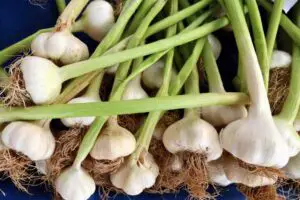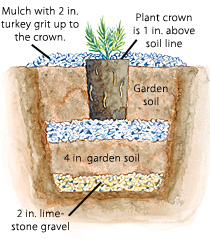
Growing garlic in Indiana is a great way to enjoy the delicious flavors of this unique vegetable. Indiana’s climate is generally well-suited for growing garlic. With a few best practices and the right variety selection, garlic can thrive when planted in Indiana.
However, garlic grows best in full sun with ample soil drainage and average temperatures between 50 and 80 degrees Fahrenheit. Garlic requires little maintenance and can be grown organically. With proper care and attention, garlic can thrive in Indiana and produce a flavorful crop that can be enjoyed for years to come.
Understanding Indiana’s Climate for Growing Garlic
A crucial factor to consider when growing garlic – or, indeed, any plant – is the local climate. It can significantly influence the plant’s growth, health, and overall productivity. In Indiana, the climate is primarily humid continental, characterized by cold winters and warm, wet summers.
This climate type, coupled with the state’s fertile soil, makes Indiana an excellent place for cultivating garlic.
1. Seasonal Variations:
Indiana experiences all four seasons distinctly. Spring and fall are relatively mild, while the summer brings warmth and humidity, and the winter introduces cold temperatures. The state’s planting zones mainly fall within the USDA Hardiness Zones 5 to 6.
The winter period is particularly significant for garlic. Garlic planted in the fall in Indiana goes through a process called vernalization – exposure to a period of cold temperatures – that stimulates bulb formation. It’s this cold, dormancy period that helps the cloves to differentiate and develop into bulbs containing multiple cloves.
2. Temperature Considerations:
The average winter temperature in Indiana ranges from 14°F to 22°F, and the summer temperature averages between 70°F to 76°F. Garlic is a hardy plant, and most varieties, particularly Hardneck types, can tolerate these cold winter temperatures, making them an excellent fit for Indiana’s climate.
3. Precipitation:
Indiana’s annual rainfall averages about 40 inches, spread relatively evenly throughout the year but with a peak in the warmer months. This rainfall level is generally suitable for garlic, which needs well-drained soil but also consistent moisture to develop healthy bulbs.
4. Summer Conditions:
During the summer growth period, when the garlic is bulking up and forming the bulbs, Indiana’s warm temperatures are beneficial. The increased daylight hours and warm temperatures help drive photosynthesis and bulb growth.
Selecting the Right Variety of Garlic for Indiana

When growing garlic in Indiana, it’s important to choose varieties that are well-adapted to the state’s climate conditions. Softneck garlic varieties tend to do best in Indiana, as they are more resilient to variations in temperature. Some top soft neck varieties to consider include:
- Music: A popular silverskin variety that produces large, mild cloves. Stores well.
- Inchelium Red: Produces beautiful, ruby red colored cloves that are slightly spicy in flavor.
- California Early: An easy-to-grow variety that matures in mid-summer. Ideal for those wanting an early garlic harvest.
- Chesnok Red: Large, attractive, hardneck garlic with deep red coloring. The flavor is bold and hearty.
- Creole: Produces huge, milky white cloves that are softneck in structure but firm for braiding or storing. Deliciously mild flavor.
Hardneck varieties can also do well; they just require slightly warmer temperatures to thrive. Try purple stripe varieties like ‘Georgian Fire’ or ‘Kettle River’ if looking for a hardy hardneck option. Research the options and choose varieties best matched to your growing zone.
How to Grow Garlic in Indiana
Stage 1: Planting Time
For best results in Indiana, plant garlic in early fall around October. The roots will begin to develop during the mild fall weather. Then, when spring arrives, the garlic will be well established to send up green shoots.
October planting allows the garlic plenty of time to grow roots and form large bulbs before the first spring frost. It also avoids issues with bolting (seed stalk formation) that can occur if planted too early in warmer zones.
Stage 2: Soil Preparation
Garlic needs well-draining, nutrient-rich soils to thrive. Before planting, work in several inches of organic matter like compost or aged manure to boost the soil’s structure and nutrient content. Garlic will also benefit from some additional fertilizer at planting time – a balanced organic fertilizer works well.
Rake the soil to break up any clumps and create a fine seedbed texture. This will allow the tiny garlic cloves to be planted at a uniform depth and give them the best start. The goal is loose, friable soil that water and air can move through freely.
Stage 3: Planting Method
Individual garlic cloves should be planted pointy end up, roughly 1-1.5 inches deep and spaced 4-6 inches apart in the prepared planting bed. Wider spaces are preferable in Indiana to allow for air circulation needed to reduce disease pressure.
Plant the cloves by hand, pressing each one carefully into the soil pointy end up. Use a dibble or old marking tool to make consistent holes for easy planting. Another option is broadcasting cloves over the soil and raking them lightly into the surface.
Water newly planted beds well after spreading cloves to encourage quick root growth. Then, mulch planted areas with 1-2 inches of organic matter, like shredded leaves, to conserve soil moisture and suppress weeds as the garlic develops.
Stage 4: Mulching and Watering Garlic in Indiana
Mulching and Watering Garlic in Indiana are two important steps in achieving a successful garlic crop. Mulching helps keep the soil warm and moist while also reducing weeds and conserving soil moisture.
Watering garlic is especially important during the hot summer months, as it helps the bulbs to mature and develop their characteristic flavor. With proper mulching and watering, garlic harvested in Indiana can be a delicious addition to many recipes.
Make sure to monitor the soil moisture and adjust watering accordingly to ensure the best results. With a little bit of effort and preparation, you can enjoy perfectly grown garlic in your home-cooked dishes.
Stage 5: Care Through the Season
For the first 6 weeks or so after planting, keep newly established garlic beds evenly moist but not soggy. This will encourage healthy root development underground.
Once green shoots emerge in late spring, care shifts to regular weeding to eliminate competition for water and nutrients. Garlic grows best in full sun but may need occasional irrigation during prolonged dry spells or heat waves.
Fertilize planted beds again 45 days after shoots emerge using a balanced organic fertilizer or compost tea. This will boost bulb development through the summer months. Monitor for common pests and diseases like onion thrips, white rot, or rust – address issues promptly if they arise.
Stage 5: Harvesting
Homegrown garlic is ready to harvest when the bottom third of the leaves begins to turn brown naturally. This usually happens in late June to mid-July in Indiana once bulbs have fully matured. Carefully dig Fork bulbs from the ground, being gentle so as not to damage the papery skin.
Lay harvested bulbs in a dry, shaded area with good airflow for 2-3 weeks to cure. Curing allows the papery skins to dry and harden fully, protecting bulbs during long-term storage. Once cured, braid garlic strands or store in breathable mesh or paper bags in a cool, dry place. Properly cured garlic will last up to 8 months or more.
Common Pests & Diseases
Onion thrips are tiny, flying insects that feed on garlic foliage and bulbs, weakening plants. To prevent this, use row covers at planting or apply approved organic sprays when thrips are active. Remove weeds and volunteer alliums near beds that can harbor pests.
Fusarium basal rot causes leaves to yellow or white streaks on bulbs. Use 3-4 year rotation, remove debris, and improve drainage. White rot causes wet, mushy bulbs. Plant resistant varieties, improve airflow/drainage, and rotate crops. Rust causes powdery spots on leaves. Remove debris and space plants farther apart for airflow.
Fertilizing garlic regularly and following good sanitation practices helps control diseases naturally without chemicals. Rotate crops, choose resistant varieties, and maintain healthy soil to minimize pest and disease pressure in Indiana garlic crops.
Conclusion
With the right planning and care, Indiana offers excellent potential for sustainably producing high-quality garlic crops year after year. Implementing best practices like soil nutrient management, crop rotation, companion planting, and natural pest control helps maintain long-term soil fertility and crop health.








2 Comments